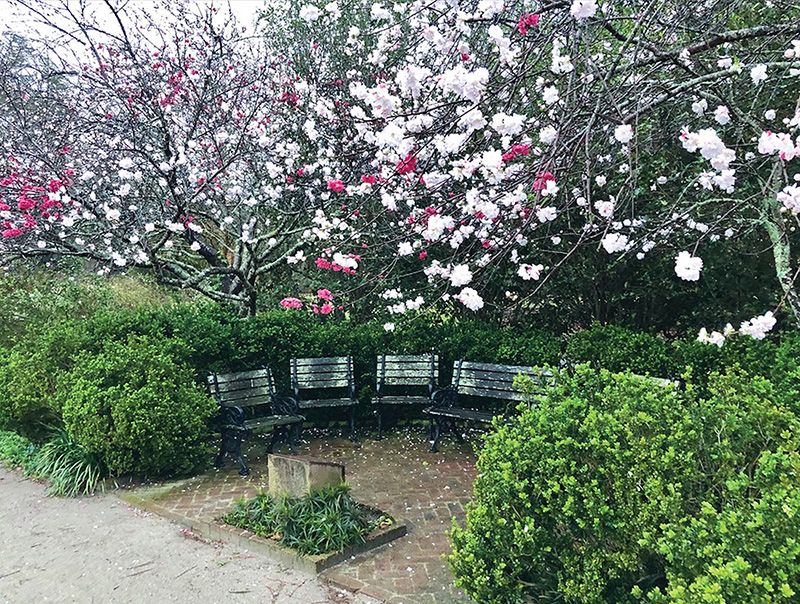Learn which local legend brought the rarities to Charleston public spaces and how to source one of your own

Near the lagoon in Hampton Park, this nook honors former mayor Joe Riley with a pair of peppermint peach trees.
In Charleston’s gardens, both public and private, there are few sights more astounding than a peppermint peach tree in early-spring bloom. On one branch, the double blossoms are all white. On the next, they’re pink. And on a third, they are—quite magnificently—peppermint striped.
How can a single plant create such a spectacle? The credit likely goes to a natural mutation in the flowering peach tree, notes the city’s director of parks, Jason Kronsberg. Nearly two decades ago, Prunus persica ‘Peppermint’ trees were planted in Hampton Park and Washington Square, as well as in a median on upper Meeting Street, at the encouragement of then-mayor Joe Riley.
Riley remembers, “My wife and I had seen a peppermint peach tree growing in a South Battery garden and found it so alluring. I love that it blooms around March 15—a time when you really welcome flowers.” The mayor showed his discovery to the parks department and even donated funds to help bring ‘Peppermint’ (which does not bear edible fruit) into city spaces.
If you set out to purchase the tree for your own landscape, you’ll find it rather elusive. Local nurseries don’t carry it, and only a few online retailers do. Vet your sources before buying off the web, advises Kronsberg, as the city has received specimens that don’t yield the coveted candy striping.
However, he assures that this rarity—which blooms for a few weeks before green leaves move in—is absolutely worth chasing. “Use it to fill a corner, or make it the centerpiece of a garden or landscape border,” he suggests. Just be certain to leave room for peppermint peaches to reach their natural size—up to 20 feet tall and wide—so that you can reserve pruning for damaged, declining, or diseased branches. “Make sure your pruning shears are clean and sharp, as improper cuts and breaks give insects and fungal issues the opportunity to invade,” says Kronsberg.
There’s no need to wait until spring to order one of these confections: trees planted this month will have time to get established before hot weather hits.

Blooms may be peppermint colored (left), all white (right), or all pink.
Prunus persica ‘Peppermint’
■ Mature Size: 15 to 20 feet tall and wide
■ Lifespan: About 20 years in the Lowcountry
■ Sunlight: Full
■ Soil: Nutrient-rich, well-draining loam
■ Water: For the first year, water regularly. Mulch soil and avoid letting it dry out.
■ Fertilizer: Feed with an all-purpose fertilizer in early spring and late summer.